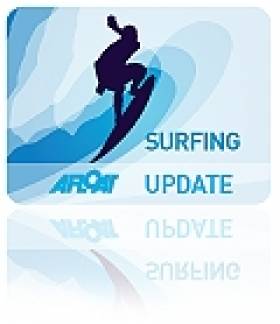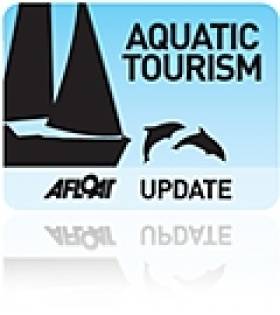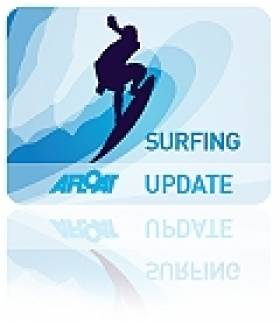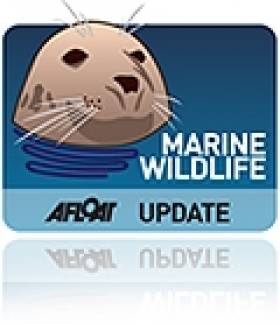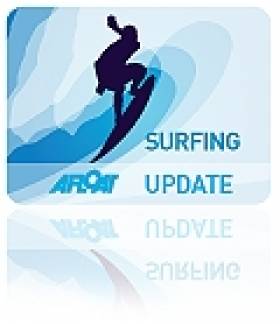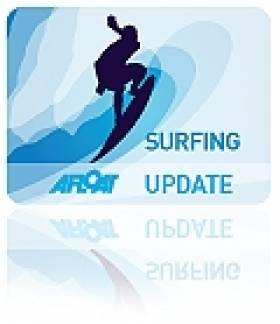Displaying items by tag: Surfing
Ireland's Most Decorated Surfer In Portugal For World Bodyboard Tour
#Bodyboarding - National Bodyboarding Champion Martin 'TK' Kelly is representing Ireland this week at the Portuguese stop on the APB World Tour for bodyboarding, as the Coleraine Times reports.
Regarded as the most decorated Irish surfer of all time, Kelly is flying the flag for the North Coast's dedicated surfing community among 140 of the world's best at Praia Grande.
And he's joined at the Sintra Pro by Sligo boarder and two-time Irish national champ Shane Meehan.
Though neither as expected to have a shot at the world crown, it will still be, in Kelly's words, "a fantastic experience" before he defends his Irish title in Bundoran at next week's Irish Nationals.
The Coleraine Times has more on the story HERE.
Northern Ireland's Top Spots For Surfing, Birdwatching
#Tourism - Where's the best place to go surfing or coastal birdwatching in Northern Ireland? The Belfast Telegraph has got you covered.
Benone Strand was previously highlighted on Afloat.ie as a top 'coastal experience' for surfing kids, and it shows up here again in Portrush surfer Al Mennie's list of recommended spots to hit the waves for locals and visitors alike.
Portrush's East Strand and neighbouring Portstewart also feature in his list that's rounded out by two picks for experienced surfers only: Portballintrae – "by far the vest area for surfing on the north coast" – and the legendary Finn MacCool's big wave at the end of the Giant's Causeway.
The causeway also crops up in Ian McCurley's choice spots for birdwatching across NI, in particular for its "colourful stonechats perches on gorse bushes; fulmars in their cliff nest sites; peregrine falcons and gannets."
Another great seabird spotting site is Strangford Lough, which the National Trust woodland and parklands manager describes as "a unique haven for biodiversity, containing many of our rare and most threatened wildlife."
Shannon Wave Surfing Could Be The Next Big Thing
#Surfing - First the Dutch are pioneering canal surfing - and now some intrepid Irish surfers are in on the act, proposing a river wave on the Shannon as the next big surfing hotspot.
The Limerick Leader reports on UL student Paul Deering and his friend Kalani Moore who have demonstrated the potential of the standing wave at Curragower Falls for more than the usual canoe paddlers.
“It could potentially attract surfers from all over the world,” said Deering, making reference to a similar wave on the Esibach in Munich, Germany that's been a focal point for European surfers since the 1970s.
The Limerick Leader has more on the story HERE.
Dutch Set To Make Urban Surfing All The Rage
#Surfing - Surfing on the canals of the Netherlands? It could be a reality if Rotterdam's plans come to fruition, as Mail Online reports.
The Dutch port city's Steigersgracht Canal is the location for RiF010, a water-purification scheme that will create a five-foot wave in the waterway that might well be perfect for 'hanging ten' in the heart of the retail district.
And not only will the wave pool be an attraction for watersport enthusiasts, it's also expected to generate electricity for the locality, making it a proper green energy scheme too.
Mail Online has more on the story HERE.
Surfing Pig Is Making Big Waves
#MarineWildlife - If last week's video of a surfing seal wasn't extraordinary enough, how about this clip of a pig riding the waves in Hawaii?
As the Irish Mirror reports, Kama the pig has gone surfing with his owner Kai Holt on the shores of Oahu since demonstrating his talent in the water after a fall into a swimming pool.
Now the porcine paddler appears to be a seasoned professional at the rides on the front of his owner's surfboard, equipped with his own GoPro camera to capture the action as he surfs and swims and trots around.
Easkey Britton To Set Up Iran's First Ever Surfing Club
#Surfing - The Irish Examiner reports on Easkey Britton's plans to return to Iran this month to establish that country's first ever surf club.
The Donegal surfing champ made history in 2011 when she became the first woman ever to surf in Iran – an extraordinary adventure that was documented by French filmmaker Marion Poizeau.
Since then she's founded Waves of Freedom, a scheme dedicated to teaching women of the remote Baluchistan region how to surf, and she returned to Iran with Poizeau, who shot more footage for a documentary feature, Into The Sea, currently doing the film festival rounds.
Now Britton's going back to the port town of Chabahar on the Makran Coast to help local surfing women set up the country's first surfing club for girls and boys.
And in doing so she's carrying on the pioneering spirit of her father Barry and his brothers Willie, Conor and Brian, who built the foundation of Ireland's own surfing community.
The Irish Examiner has much more on the story HERE.
Young Seal Goes Surfing Off North Sea Coast
#MarineWildlife - This surfing duo off Amble in Northumberland had a surprise partner join in the action, and captured it all on video!
As the clip above shows, the young seal comes out of nowhere as Matt Stanley and Andrew Flounders were paddling in the water - and even leaps onto Matt's board to try it out for himself.
Luckily for the pair, the surfboard had a waterproof camera attached to record the whole thing, so they had evidence to back up their story to the rest of us back on dry land!
Mail Online has more images from the young seal's surfing adventure HERE.
Documentaries Capture Irish Surfing's Past And Present
#Surfing - The video above, via The Score, captures the various surfing adventures of Meath native Maxie Hill, who left Ireland's shores for the waves of Indonesia for what was planned to be a three-month trip.
But five years on, he's still spends much of his time in South East Asia, supporting his surfing habit as a chef Australia - working for Rick Stein, no less.
His short film A Letter To Home is a fitting self-shot tribute to the waves that drive his passion.
That's a passion shared by the Britton brothers of Rossnowlagh in Co Donegal, whose lives changed forever when two of the first surfboards ever used in Ireland fell into their laps in the early 1960s.
The Irish Times recounts the incredible story of these four brothers – Barry, Willie, Conor and Brian – who taught themselves how to surf from movies and magazines, and became the foundation of Ireland's surfing community as we know it today.
If not for them we wouldn't have the Irish Surfing Association as we know it, nor would we have Barry's daughter Easkey Britton, a world-class surfer and pioneer in her own right.
The Britton brothers are the subject of a recent RTÉ Radio documentary, The Beach Boys of Rossnowlagh, that's available to stream or download HERE.
#Surfing - The family of an Irish surfer in Australia who went missing after he and two friends were pulled out to sea by a rip current have expressed their hope that he will be returned to them.
As previously reported on Afloat.ie, the incident prompted a major search and rescue effort in treacherous conditions off Tallow Beach on Byron Bay, south of the Gold Coast in New South Wales last Saturday morning (19 July).
The missing man has since been named by Independent.ie as 20-year-old Stuart Butler from Santry, who had joined two friends, Levi Fahrenholtz (25) from the US and Mike Fuller (19) from England to go boarding at the popular surfing spot.
Fuller managed to reach nearby rocks when the rip current pulled them away from the beach, and Fahrenholz was later rescued after he was swept around Cape Byron, but all trace of Butler's whereabouts was lost.
The North Dubliner is officially listed as a missing person, though it's been confirmed that the search effort is "now a body recovery operation".
Independent.ie has more on the story HERE.
Irish Surfer Missing Off Eastern Australian Coast
#Surfing - The Irish Times reports that the search for an Irish surfer missing since Saturday morning (19 July) off Cape Byron in Australia was suspended earlier today in fading light and treacherous conditions.
The 19-year-old was surfing with two friends when they got caught in a rip current near Tallow Beach, south of the Gold Coast in New South Wales.
One of the two rescued, aged 26, was helped from the water unharmed, while the other, aged 20, was found on nearby rocks with minor injuries.
Local surf clubs have joined in the search and rescue operation attended by helicopters and jet ski crews. The Irish Times has more on the story HERE.


























